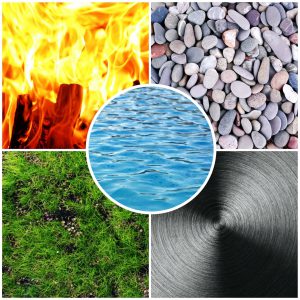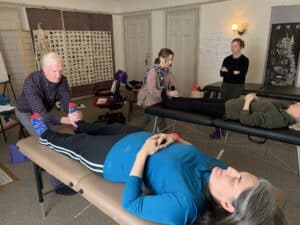 Acute Stress, Trauma and the Water Element
Acute Stress, Trauma and the Water Element
How do you feel when someone cuts you off in traffic? Most of us are familiar with the acute stress response (ASR) – the surge of fear and tension that takes over when we face threat. The response is so fast and instinctive that we may feel we have been temporarily hijacked by our own nervous systems. Ancient Chinese medicine physicians understood ASR very well through Five Element acupuncture theory. They knew how it impacted the rest of the body-mind systems. They understood how to treat it when things went wrong. This article delves into the connection of ASR, trauma and the Water Element in Five Element acupuncture. It offers a practical framework to understand and heal from the health impacts of trauma and chronic stress.
Physiology of Acute Stress Response (ASR)
What happens when we feel threatened? Our body floods us with chemical messages to activate the fight-or-flight response (sympathetic nervous system). Adrenaline, osteocalcin and other stress hormones send signals to the rest of the body to respond. Breathing becomes rapid, heart rate increases, and we may feel our chest pounding. We get a burst of energy as glucose is released to fuel the response. Muscles tense up to get ready to flee or fight. In the extreme, panic and anxiety may take over. We may break out in a sweat, or even lose control of bladder and bowels. All of this happens so quickly that it is almost instantaneous, allowing us to get out of the way of a speeding car without having to think about it. For a short while, primal instinct takes over to get us out of danger.
After the initial surge of adrenaline, if stress or danger continues, a second part of the stress response kicks in, known as the HPA (hypothalamus, pituitary, adrenal) axis. A cascade of hormonal signals prompts the adrenal glands to release cortisol, keeping us revved up and on high alert.
If body and mind are healthy, cortisol levels will fall once danger is passed. We are able to quickly soothe and return to a calmer state of rest-and-digest (parasympathetic nervous system). Proper balance of nervous system response – alertness to threat, and calming in safety – is critical to long-term health.
Chronic Stress, Trauma and Illness
If someone is under chronic stress or has a personal history of trauma, this system may be damaged. A person may be left in a state of hyper-alertness, unable to calm and soothe. Or, she may perceive a threat where there is none, triggering ASR inappropriately.
Long-term stress and trauma can leave a person stuck in fight-or-flight, leading to a cascade of problems throughout the body. Cardiovascular health, digestion, brain health and immune function may all suffer if the body’s metabolic resources are constantly being prioritized to fuel ASR. Chronic stress may contribute to anxiety, depression, high blood pressure, heart disease, weight gain and premature aging.
Relationships may suffer, too. When there is post-traumatic stress, a person may frequently perceive threat when there is none. They may misinterpret safe situations as threatening, thwarting their ability to engage in social relationships.
The CDC-Kaiser Permanente ACE (adverse childhood events) study, one of the largest studies of childhood abuse and neglect ever conducted, showed an adverse impact of early childhood trauma on nearly every long-term health outcome. Traumatic stress is a public health emergency.
Winter and the Water Element
Long before neuroscience and western biomedicine began to tease apart the complex biochemical relationships of the mind-body connection, ancient Chinese physicians observed and understood these relationships through Five Element theory. The Five Elements are organizing principles, reflected in the seasonal phases of the year. The Five Elements are also understood to correspond to functional relationships, emotions, organs and tissues within the human being.
The Water Element in Five Element theory represents the primal instinct for survival, corresponding to the season of Winter. Winter is a stressful time for living organisms. It is a time of darkness and stillness in nature, when the life force contracts inward. Plants go dormant, as the life energy is conserved in root and seed. Many animals hibernate or move about less to conserve energy. Food sources are scarce, and the weather is cold, adding to the challenge of survival. Human beings, as well, hunker down in Winter. It is time for rest, contemplation, and self-care, ensuring our survival until Spring returns.
The Water Element, like Winter, is about basic life survival. Water itself is in every living cell of our bodies, and we can only survive a very short time without it. Either too little water or too much can kill us. Water, as a liquid, take the shape of the container it is in. It may be very still, even frozen, if it is contained in a lake or reservoir. Unrestrained and flowing, water is powerful and persistent. Regulating and controlling water, with dams and dykes, has been essential throughout human history. Most of our natural disasters – tsunamis, floods, droughts and even wildfires – have to do with either too much or too little water.
For more about the Winter and the Water Element, watch the video, or read about Water and the will to survive.
Fear, Trauma and The Water Element
Within the human body, the Water Element corresponds to the biological systems most closely related to basic survival of the organism and species – instinct, reproduction, development and senescence (aging). In other words, the Water Element governs what we inherit and what we pass on.
Five Element acupuncture theory views the various body systems as members of a team (called the “officials”) who have to work together. In order to maintain health and harmony, each member of the team has to do its job. The “officials” of the Water Element are the Kidneys and Urinary Bladder.
The adrenal glands, which sit atop the kidneys anatomically, are considered part of the Kidney “official” in Five Element theory. In Western biomedicine, the adrenal glands are understood as a key part of the endocrine system. The endocrine system produces hormones that regulate many things – including growth, development, metabolism, sexual function, reproduction, sleep and stress response – all of which correspond to the Water Element’s basic function of primal survival. The adrenal glands release adrenaline, one of the hormones involved in initiating ASR.
Emotionally, the Water Element governs fear in its most basic, instinctive form. Fear gives us the ability to mobilize in response to danger, initiating the ASR and allowing the person to either flee from danger or fight it. An imbalance in the Water Element may leave a person unable to initiate ASR, or, alternatively, stuck in a state of hyper-arousal.
An imbalance in the Water Element is very deep and the impact is widespread. If a person is stuck in a state of chronic fear, it robs other body systems of needed resources. It can show up in many areas – heart, lung, nervous, immune systems, to name a few. All of the Five Elements “officials” may share the damage.
Treating Trauma and the Water Element
Treatment with Five Element acupuncture can help support and balance the Water Element. By shifting the person out of habituated fear and soothing the nervous system, it helps create a healthier baseline and a greater sense of safety. Healing from the effects of traumatic stress is a long-term process. The healing journey may involve new wellness habits and other healing modalities, such as Zero Balancing. Five Element acupuncture can be part of the journey, balancing and harmonizing all of the Elements within.
Part II of this article will delve more deeply into how an imbalance in the Water Element impacts other body systems. It will also explain how the Water Element governs sensory organs and body tissues, especially the ears and the skeleton, and the role they play in ASR and trauma.
References
Alaine D. Duncan. The Tao of Trauma. North Atlantic Books, 2019.
Claude Larre and Elisabeth Rochat de la Vallee. The Kidneys. Monkey Press, 1989.
J.R Worsley. Classical Five Element Acupuncture, Vol. III: The Five Element and the Officials. 1998.
Inner Works Acupuncture is a Five Element acupuncture clinic in the Alphabet district of northwest Portland, offering treatment for chronic health conditions and the body-mind impacts of traumatic stress. For more information or to schedule an appointment, call 503-227-2127.



